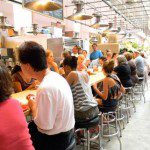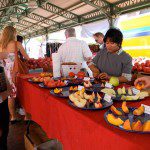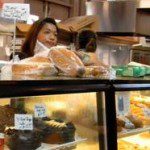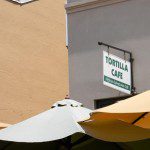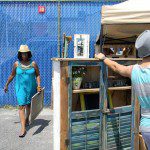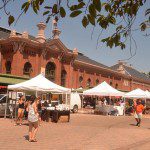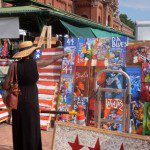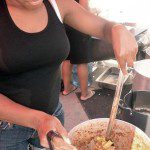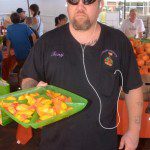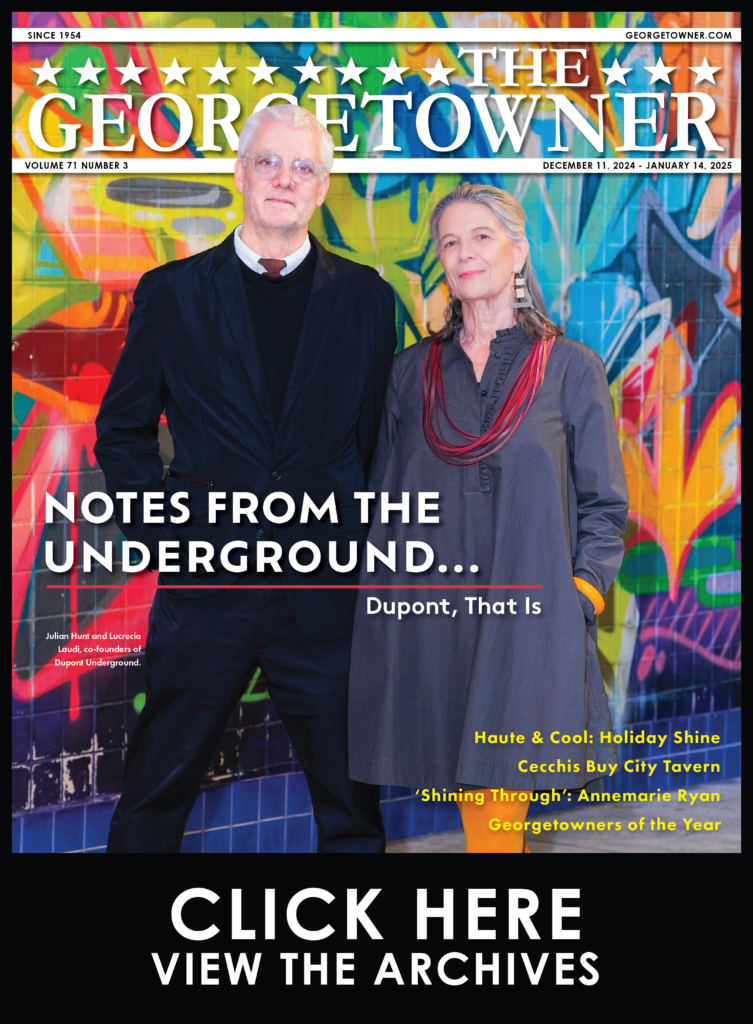The Eastern Market Experience
By • June 18, 2013 0 1774
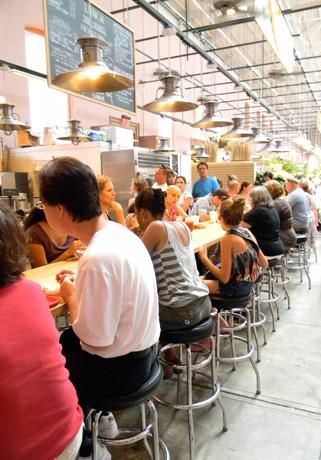
You know what this place reminds me of?” spoke a passerby inside Eastern Market’s 19th-century brick building last Saturday, surrounded by specialty food vendors offering everything from meat and poultry, to cheese, baked goods, pastries and flowers. “Florence.”
Outside, amid the produce stalls surrounding the main building, where local farmers come every weekend to sell their seasonal bounty, a woman burst out upon sampling a fresh tomato: “It’s as good as they are in California!”
Behind the North Hall entrance, breakfast and lunch stands sell loaded crepes, fresh mini-donuts and lemonade, gumbo, a variety of flavored pickles and much more. It’s like walking into a food cart consortium in New Orleans. Lines snake about in makeshift fashion, an eclectic maze of all the Federal city’s inhabitants. Families and three-piece suits intermingle with hipsters and seniors, dog-walkers and local teenagers, all generously interspersed with young thirty-something couples.
Eastern Market, among many other apt definitions and descriptions, is a cultural hub for the city and surrounding area. People talk here. A lot. People stroll without agenda through the pleasant but crowded vendor aisles. They laugh easily. They actually sit on public benches and drink coffee. They get caught up in the sensations and hum of this open-air market that is utterly unique to the nation’s capital. Just the scents you experience are enough to tell the story: lavender soaps and handmade candles, lacquered wood and grilled tortillas, peaches, cucumbers, honeycomb, watermelon, roses, lilies, lemons, fried fish.
In this sense, Eastern Market is also as close as modern-day Washington gets to Southern culture, in pace and in attitude. Frequent the market enough, and you will be on a first-name basis with the farmers and food vendors. You will begin to run into other neighborhood regulars, who come to do most of their shopping here—the indoor vendors, who are open every day of the week, together function in the style of a European market, with each independent merchant specializing in a particular good (seafood, meat, cheese, baked goods, etc…).
However you decide to culturally classify Eastern Market, it is a buzz of excitement, community, food, music, art and local flavor. Summer is in full swing, but it will be over before you know it. If you don’t live on Capitol Hill already, pick a weekend morning and discover it again or for the first time. Here are some longtime Market staples and a few great new additions to the Eastern Market family to guide your explorations.
Weekend Farmers’ Line
Surrounding the market in the shade of a covered sidewalk, area farmers empty their trucks of recently harvested produce each weekend. They haul in from Delaware, Pennsylvania, Maryland, Virginia and West Virginia with a smorgasbord of fruits, vegetables, homemade jams, local honey, fresh flowers, pies, homemade breads and even specialty spreads (stop by Wisteria Gardens’ stand for a sample of the basil and ginger hummus—made seasonally).
Tony, of Dunham’s Produce stand, holds a plate piled high with chunks of fresh peaches, which passersby pick at joyfully and without much constraint. Every tenth customer or so is so overwhelmed by their flavor that they buy a few—and ten customers come around in no time in an Eastern Market weekend. His farm, based in Berkeley County, W. Va., has come to sell their produce at Eastern Market every weekend for more than 30 years.
“Right now we’re selling peaches, heirloom tomatoes, strawberries, nectarines, watermelon—summer produce,” he says. “When fall comes around, we start selling honey crisp apples and your fall produce. And two days after Thanksgiving, we’re back here selling Christmas trees.”
Tony also let on that West Virginia is a major peach-producing state, with great quality fruit and high yield. We got to stop giving Georgia all the credit.
Just down from Tony, Ma Brown has manned her booth for 33 years and hasn’t forgotten a moment of it. A Brooklyn native, she moved to the District in 1968 and opened her Eastern Market stand in 1979. “I sold ginger beer—and regular beer back then,” she says. “There used to be auctions in the market on weekends, selling antiques and whatever else. And they would send the bidders out to get a drink from me, so they would loosen up and bid higher.”
She now sells a variety of tonics and baked goods—she calls them her “sweet sins.” Her homemade strawberry-ginger lemonade is something everyone should try, and her pecan and pumpkin pies are impossible to beat.
Many of these farmers and vendors have been around just as long as Tony and Ma Brown, and there is a warmth and familiarity about the community that you don’t find very often.
South Hall Market
Much like the Farmers Line outside, it is a combustible drum of activity each weekend—and most weekdays—inside the market. Thirteen vendors hold shop, among them Southern Maryland Seafood, Canales Delicatessen, Market Poultry, Bowers Fancy Dairy Products, and Blue Iris Flowers. A throwback to a different era, within these walls a way of life is preserved that has all but vanished from American cities: the local markets.
If you want meat, go talk to the butcher. Pastries and fresh bread is over at the Fine Sweet Shop. In the South Hall Market, the grocers and shopkeepers are part of the shopping experience.
Blue Iris Flowers is another member of the old guard, an Eastern Market stand that has been in operation for well over 30 years. Angie Brunson, who opened and runs the shop, has a reputation for putting together some of the finest floral arrangements in the area.
Market Lunch, the indoor market’s only restaurant, is another local staple. A favorite breakfast and lunch spot among neighborhood residents, Market Lunch is always bustling at mealtime—the line often wraps around itself (though it moves quickly) and on weekends it can be hard to find a seat at the 20-foot long bar-top table, where patrons sit elbow to elbow to chow down on their tasty American fare. Breakfast favorites include blueberry buckwheat pancakes, and the lunch menu teems with classic East Coast staples, such as fresh fish and oyster sandwiches, soft shell crabs and charbroiled burgers.
Outdoor Eating
On weekends, Market Lunch gets a little friendly competition. The outdoor food stands at the market’s north end are all pretty spectacular. Sweet Nuthouse is a family-owned specialty nut business that has been selling in Eastern Market for several years. Perfect for snacking or gifting, its offerings include Praline Glazed Pecans, Cinnamon Almond Crunch and, during the cooler months, Sweet & Spicy Almonds, all made without preservatives, artificial ingredients, dairy, butter or gluten. At the heart of Sweet Nuthouse’s business is its insistence on freshness. It is quite likely that the nuts you buy at the Market are just a day—or even hours—away from the time that they were made.
For a serious meal, this author’s favorite stop is Puddin’, a stand that cooks up divine comfort food—and regardless of your definition of “comfort food,” it’s hard to argue with how good this food is. Puddin’s chicken and sausage gumbo is the real thing, and its shrimp and grits hit the spot any time of year. But it’s the brown butter bourbon bread pudding that will keep you coming back. Owner Toyin operates Puddin’s food stand on weekends as a branch of her catering business, which sources from local vendors.
Other vendors sell wood-fired pizza, made-to-order fresh donuts, crepes, and an array of delicious and funky pickled pleasures.
There are also a few regular “dine-in” restaurants lining the adjacent street. The Mexican-Salvadoran cuisine at Tortilla Café has a huge cult following—café manager Catalina Canales knows what she is doing. Her pork and cheese pupusas are famously tasty, and her tamales, empanadas and Salvadoran chicken sandwiches are all great bets. The eatery was featured on Food Network’s Diners, Drive-ins and Dives in 2010, where host Guy Fieri said, “You gotta come try this. I’m not kidding you.”
Where All the Books Go
“This is a book store and not a phone booth,” says Jim Toole, owner of Capitol Hill Books, just across the street from the south end of the market. What he means is that he doesn’t allow cell phone conversations in his store. “There are [also] words and phrases that you can’t use in my store: like, oh my God, neat, sweet, have a good one, that’s a good question, totally, whatever, perfect, Kindle or Amazon. These words give me brain damage. I’m serious,” he adds.
If these words resonate with you, for reasons on which I won’t elaborate, Capitol Hill Books is the place for you. A small, unadorned townhouse (save an awning with the shop’s name) sandwiched on a block of converted residential spaces, Capitol Hill Books is crammed from floor to ceiling with more than 20,000 used books from every genre imaginable. Fiction, poetry and the mystery room are upstairs. Art and cooking is in the back. Russian literature is in the bathroom. And so on, in that order.
This cavernous old townhouse is a reader’s quirky paradise. It’s the kind of place where you stumble across an unknown book by an unknown author, sit down to glance at the first couple of pages, and then realize three hours later that you’re late for your lunch appointment. Capitol Hill Books is the best used book store in the city—go there and see for yourself.
There is so much more to Eastern Market than can be understood without being experienced. It is a slobbery dog bumping your leg as you step back to admire a piece of jewelry. It is antiquing, discovering quirky, beautifully handmade and historic furniture, tiles, clothing, sculptures and paintings. It is a scene, a feeling, a spectacle. It is taste, sight, smell and sound. It is conversation, community and friendship. This is where you go on the weekend to take your time, to break distinctly from your work-a-day weekday pace. Eastern Market is just a good place to exist, and there’s nothing else quite like it in Washington, D.C.
- Patrons chow down at Market Lunch in the South Hall indoor market, a favored breakfast and lunch spot always bustling at mealtime. Breakfast favorites include blueberry buckwheat pancakes,and more. | Ari Post
- Jordan Wright
- Photo by Aaro Keipi |www.aarography.com
- Jordan Wright
- Jordan Wright
- Jordan Wright

